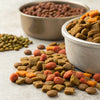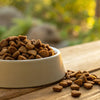How to Make Dry Dog Food Wet: Transforming Your Pup's Meals
- Houndsy
Table of Contents
- Introduction
- Understanding Dry Dog Food
- Benefits of Wetting Dry Dog Food
- How to Make Dry Dog Food Wet
- Common Concerns and Considerations
- Reflecting on Your Pet's Feeding Routine
- Conclusion
Introduction
Did you know that nearly 60% of dog owners report their pets sometimes refusing to eat their dry kibble? As loving pet parents, we often strive to make mealtime enjoyable and nutritious for our furry companions. However, there can be challenges with dry dog food, particularly when it comes to palatability and ease of digestion. This is where the magic of transforming dry dog food into a wet meal can make all the difference.
In today's blog post, we will guide you through the process of making dry dog food wet, exploring various techniques and benefits. By the end of this post, you'll have a comprehensive understanding of how to enhance your dog's mealtime experience, ensuring that they stay happy, healthy, and hydrated.
We will cover various methods to moisten kibble, discuss the benefits of wetting dry food, and address common concerns pet owners have regarding this practice. Whether you have a senior dog with dental issues or a pup that simply needs a little extra encouragement to eat, there's a solution here for every pet owner. So, let’s dig in!
Understanding Dry Dog Food
Before we dive into the methods of making dry dog food wet, it’s essential to understand what dry kibble is and why many pet owners choose it as a primary food source for their dogs.
What is Dry Dog Food?
Dry dog food, often referred to as kibble, is a convenient and cost-effective option for feeding our pets. It consists of various ingredients, including meat, grains, vegetables, and supplements, crafted into bite-sized pieces. The primary advantages of dry dog food include:
- Shelf Stability: Kibble can be stored for longer periods without spoiling, making it a practical choice for busy pet owners.
- Dental Health: Some kibble varieties are designed to promote dental health by reducing plaque and tartar buildup.
- Nutritional Balance: High-quality kibbles are formulated to meet your dog's nutritional needs, offering a balanced diet.
Despite these benefits, there are situations where dry food alone may not be sufficient or suitable for your dog, leading us to the topic of how to make dry dog food wet.
Benefits of Wetting Dry Dog Food
Wetting dry dog food offers several important benefits:
1. Improved Palatability
One of the primary reasons dog owners choose to moisten dry kibble is to enhance its taste and aroma. Dogs are often more attracted to wet food, which can help entice picky eaters or those who have recently lost interest in their meals.
2. Increased Hydration
Hydration is crucial for a dog's overall health. Many dogs do not drink enough water, leading to potential health issues. By adding water or broth to their kibble, we can help ensure they consume adequate fluids during mealtime.
3. Easier Digestion
For older dogs or those with dental issues, dry kibble can be challenging to chew and swallow. Soaking the kibble can soften it, making it easier to digest and reducing the risk of choking or discomfort during meals.
4. Enhanced Satiety
Soaked kibble expands in size when moistened, which can help your dog feel fuller after eating. This is particularly beneficial for dogs that tend to eat too quickly or those on weight management plans.
How to Make Dry Dog Food Wet
Now that we understand the benefits, let’s explore various methods to transform dry dog food into a wet meal. These techniques can be tailored based on your dog's preferences and dietary needs.
Method 1: Soaking with Water
This is the simplest method and requires only water and time. Here’s how to do it:
- Measure the Kibble: Start by measuring the appropriate amount of dry kibble according to your dog's feeding guidelines.
- Add Water: Pour an equal amount of warm or cool water over the kibble. A standard ratio is about 1 cup of water for every cup of kibble, but you can adjust based on your dog’s preferences.
- Let it Soak: Allow the kibble to soak for about 15-30 minutes, or longer if desired. As the kibble absorbs the water, it will expand and soften.
- Serve: Once the kibble has absorbed the water, mix it well and serve it in your dog's bowl. This method is especially beneficial for dogs with dental issues.
Method 2: Adding Broth
For a tastier option, consider using low-sodium chicken or beef broth instead of water. Here’s how to prepare it:
- Prepare the Broth: Choose a high-quality broth that does not contain any harmful ingredients like onions or garlic.
- Mix with Kibble: Pour the broth over the kibble in the same manner as you would with water, using a 1:1 ratio.
- Soak and Serve: Allow the mixture to sit for about 15-30 minutes, then serve it to your pup. The added flavor can make mealtime much more appealing!
Method 3: Using Canned Food
Mixing canned food with dry kibble is another excellent way to introduce moisture and enhance the flavor of your dog's meal.
- Choose the Right Canned Food: Select a high-quality canned food that complements your dog’s dry kibble. Look for options that are free from artificial additives.
- Combine: Mix a portion of canned food with the dry kibble. You can start with a 1:2 ratio (1 part canned food to 2 parts dry kibble) and adjust based on your dog's preference.
- Serve Immediately: Canned food may spoil if left out for too long, so serve it fresh to your pet.
Method 4: Using a Food Processor
If your dog requires a very soft texture, you can use a food processor to further blend the soaked kibble.
- Soak the Kibble: Use the soaking method described above with water or broth.
- Blend: Once the kibble has softened, transfer it to a food processor and blend until you reach the desired consistency. You can add more liquid as needed.
- Serve: Serve the blended kibble in your dog’s bowl, ensuring it’s fresh and appetizing.
Common Concerns and Considerations
While wetting dry dog food has many benefits, there are some important considerations to keep in mind:
Bacterial Growth
One of the primary concerns with moistening kibble is the potential for bacterial growth. It’s crucial to never leave soaked kibble out for more than an hour, as this can lead to spoilage and health risks for your dog. Always serve fresh food and refrigerate any leftovers.
Caloric Intake
Wetting dry food can cause it to expand, leading some pet owners to wonder if their dog is receiving enough calories. Be mindful of portion sizes and adjust accordingly based on your dog's weight and activity level. Consult your veterinarian if you have any concerns regarding your dog’s diet.
Dental Health
While soaking kibble can benefit dogs with dental issues, it’s essential to maintain a balance to ensure your dog’s dental health isn't compromised. Consult with your veterinarian to determine the best feeding practices for your dog’s specific needs.
Reflecting on Your Pet's Feeding Routine
As pet owners, our goal is to provide the best care possible for our furry friends. Reflect on your dog's current feeding routine: Is it time to make adjustments? Are they enjoying their meals? Could they benefit from a little extra hydration or flavor?
By exploring how to make dry dog food wet, we can enhance our pets' mealtime experiences, ensuring they stay healthy and happy.
Conclusion
Understanding how to make dry dog food wet not only enhances our dog's eating experience but also promotes better hydration, digestion, and overall health. By utilizing simple methods such as soaking, adding broth, or mixing canned food, we can cater to our pets' preferences and needs.
If you're looking to elevate your dog's feeding experience even further, consider incorporating the Houndsy Kibble Dispenser into your routine. This innovative product allows for perfect portion control and minimizes mess, making mealtime a breeze for both you and your pup. Explore the Houndsy Kibble Dispenser here.
FAQ
1. Is it safe to soak dog food overnight?
Soaking dog food overnight is not recommended, as it can lead to bacterial growth. It’s best to soak kibble for no more than an hour before serving.
2. Can I use hot water to soak dry dog food?
While warm water can help speed up the soaking process, it’s best to use lukewarm or cool water to avoid cooking the kibble and altering its nutritional content.
3. How often should I moisten my dog's dry food?
Moistening your dog's dry food can be done regularly, especially if your dog shows signs of dental issues or dehydration. However, it’s essential to monitor their overall diet and consult your veterinarian for personalized advice.
4. Will adding water to kibble change the nutritional value?
Adding water does not change the nutritional value of dry kibble; it simply enhances the texture and palatability. However, be mindful of portion sizes to ensure your dog receives the appropriate caloric intake.
5. What if my dog doesn't like soaked food?
If your dog is hesitant to eat soaked food, try experimenting with different methods, such as adding broth or mixing in canned food. Every dog is unique, so it may take some trial and error to find what works best for your pet.












